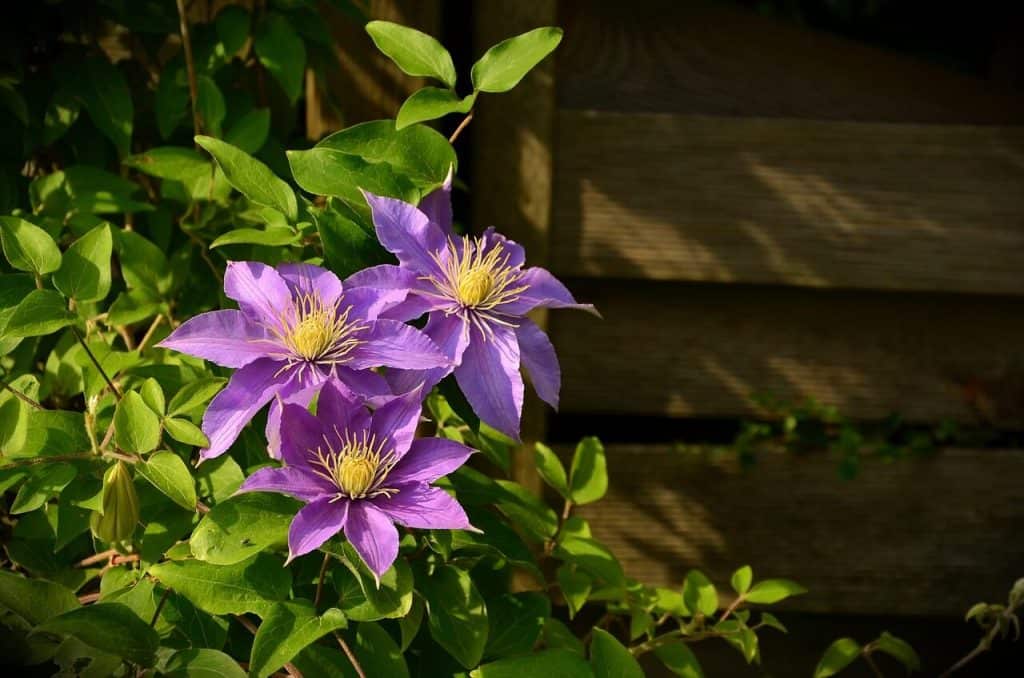Flowering vines give the garden a whimsical look, scampering up mailbox posts, porch pillars and fences. They add color and cover otherwise bare spots with a shroud of colorful flowers. While there are many kinds of flowering vines, the Clematis is a perennial returning every year and is known for their abundance of blooms. Loved by butterflies, Clematis is part of the Buttercup Family and include over 300 species worldwide. Wild Clematis can be found growing along creeks and streams in Ohio. There are hundreds of varieties ranging from small bell shaped flowers to huge double blooming flowers. Some vines grow 6 feet (1.83 m), while others can cover the side of an entire shed or garage. They are usually hardy in zones 4 to 9. Even after blooming their silvery seed heads add interest to the garden.
While Clematis are not difficult to grow, they can sometimes be a little finicky. The old adage is, Clematis like their feet in the shade and their heads in the sun. They need at least six hours of sunlight to bloom, but they like their roots to be cool. It is a good idea to mulch the vine after planting. They should be placed in the ground as the same depth they are in the pot. The crown of the plant should be just below the ground. The hole should be wide enough to fan out the delicate roots. In my experience I feel the vine will grow better if the plant has a large, well-developed root system. Sometimes it may take a year or more for the Clematis to settle in and bloom. Even if everything is done correctly there are times when the plant just isn’t happy where it is planted. After a year or so you might have to dig it up and plant it in a new location.
Pruning the Clematis vine is vital to its success. The vines fall into three groups. Often when a Clematis is purchased there is no indication of what pruning group it falls under. You might need to do a little research to find out how it should be treated. Another problem is remembering which pruning groups the vine belongs too. In my case I have several Clematis vines planted in close proximity of each other and it can be difficult to know which vine belongs to which plant and the rules to prune the vines.
Clematis Pruning Groups
Group One: These flowers generally bloom early in the spring and bloom on old wood or last years growth. If they need any light pruning to control their size, it is best to do so immediately after they bloom.
Group Two: These bloom in late spring to early summer. They bloom on the side shoots of last years growth. They first bloom on old wood and then again on new growth. Only light and careful pruning is needed.
Group Three: These Clematis bloom on new wood in mid to late summer and early fall. These vines can be cut back to within 6 to 12 inches from the ground in late winter before they begin to grow. They are often grown scampering through roses or shrubs.
There are a variety of diseases that can attack Clematis. There are molds, fungus, rust, root rot, leaf spot, bacterial and viral infections that can harm the vines. One bacteria is very fast acting. The vine can look the picture of health one day and be wilted and blackened the next by a nasty fast acting bacterial infection.
Some of my favorite Clematis include a very popular one called, ‘Jackmanii.’ It produces an abundance of large purple flowers. For a little spice in the garden I like the purple flowering Clematis streaked with white, called, ‘Tie Dye.’ ‘Henryi’ has large white flowers. Many have large double flowers such as ‘Josephine’ and ‘Blue Light.’ In 2017 a hotly sought after, fully double purple Clematis called, ‘Taiga’ was introduced at the Chelsea Flower Show in the U.K. ‘Sweet Summer Love’ produces a mass of small star-shaped purplish red flowers with a very sweet fragrance. My most favorite is the ‘Sweet Autumn’ Clematis that blooms in late summer on a very vigorous vine that can cover the side of a small building. The vine is engulfed with hundreds of small sweetly fragrant pure white flowers. After it blooms the attractive silvery seed heads continue to add flair to the late fall garden.
Don’t allow the challenges of growing Clematis hinder you in planting a few in your garden. They come in a variety of sizes, shapes, and colors and are absolutely stunning when in bloom!
Ask the Gardener
If you have any gardening questions you would like to ask Rick or topics you would love to see him cover please feel free to drop him a note and ASK THE GARDENER here.
———————————————–
———————————————–
Photo Source congerdesign from Pixabay
